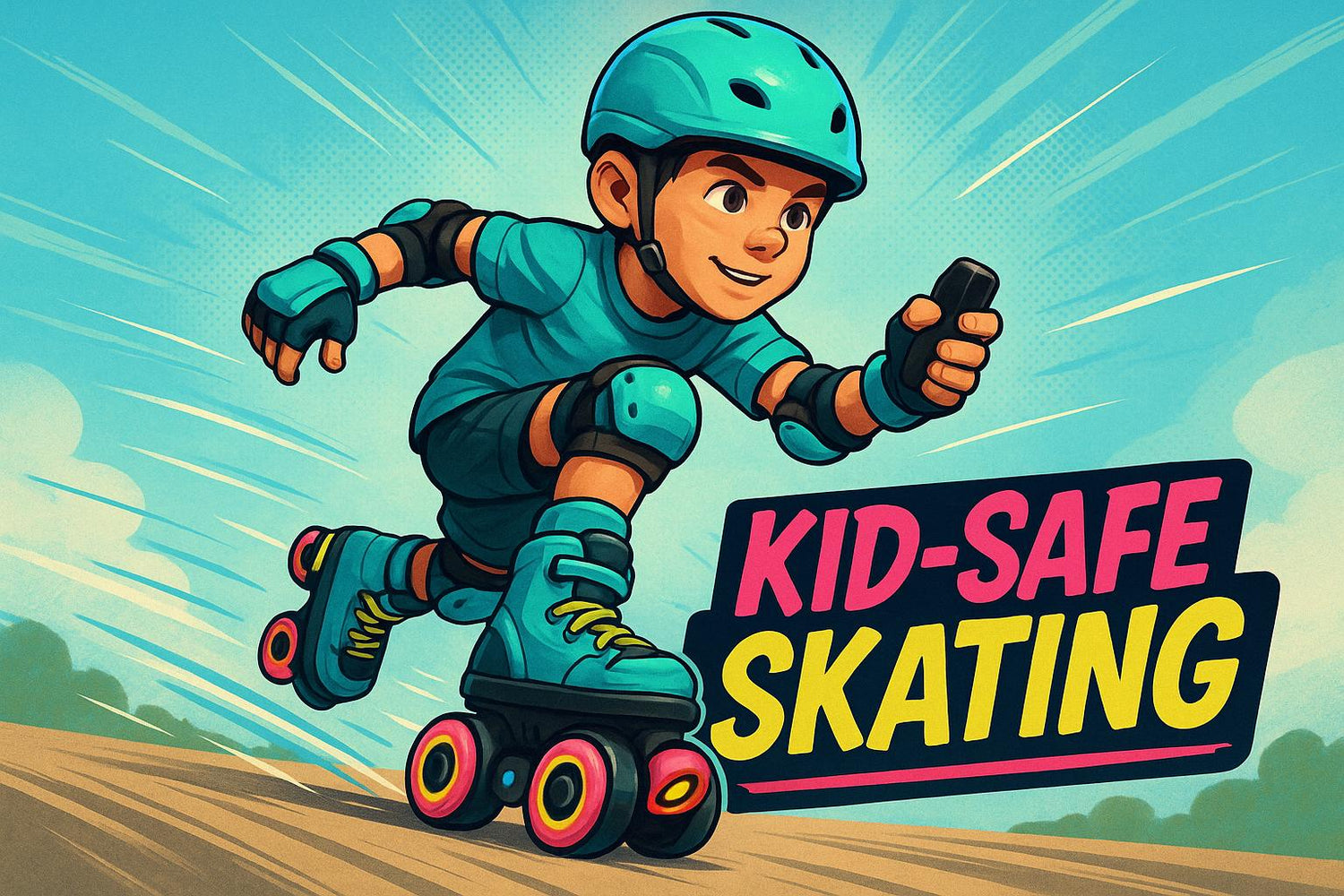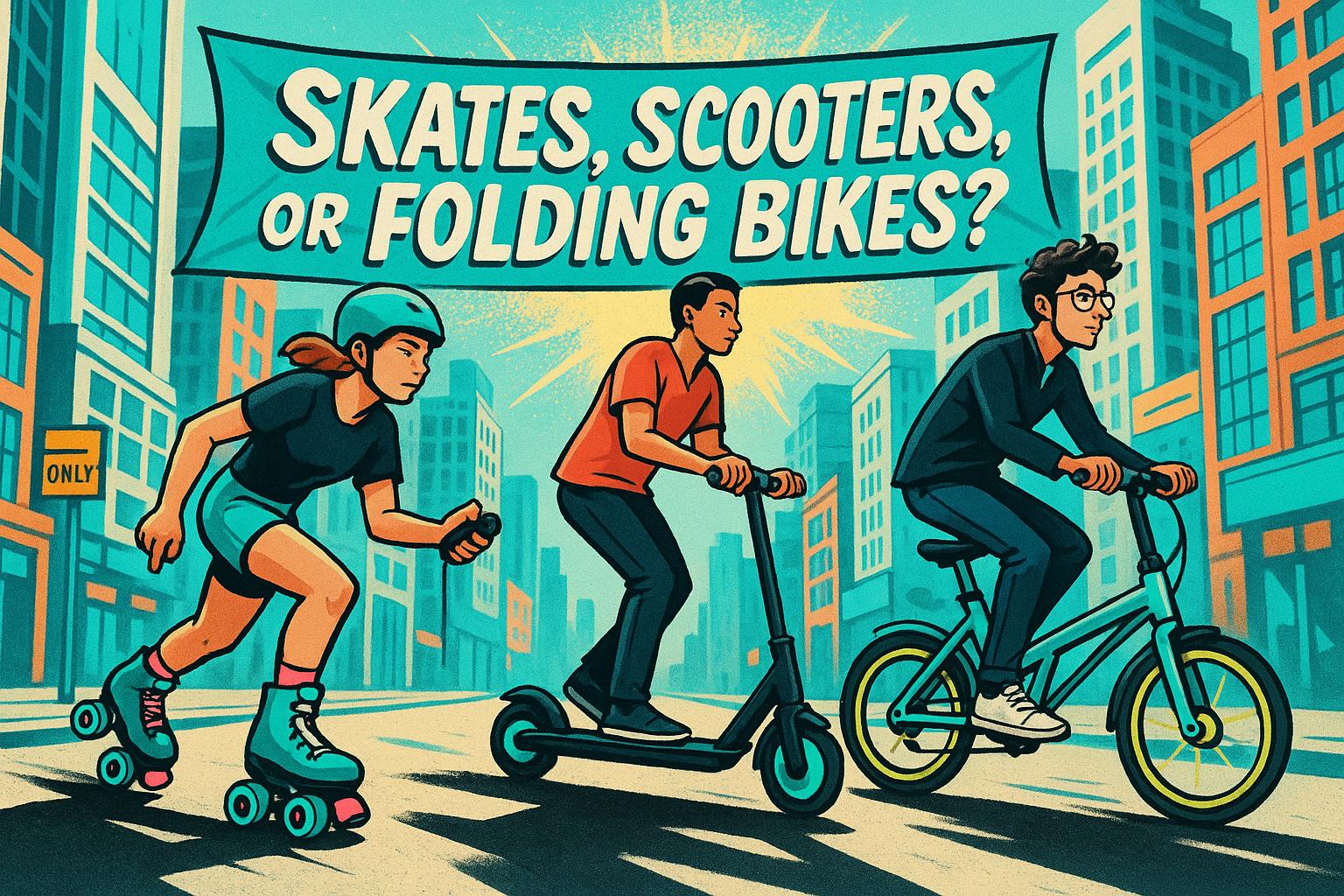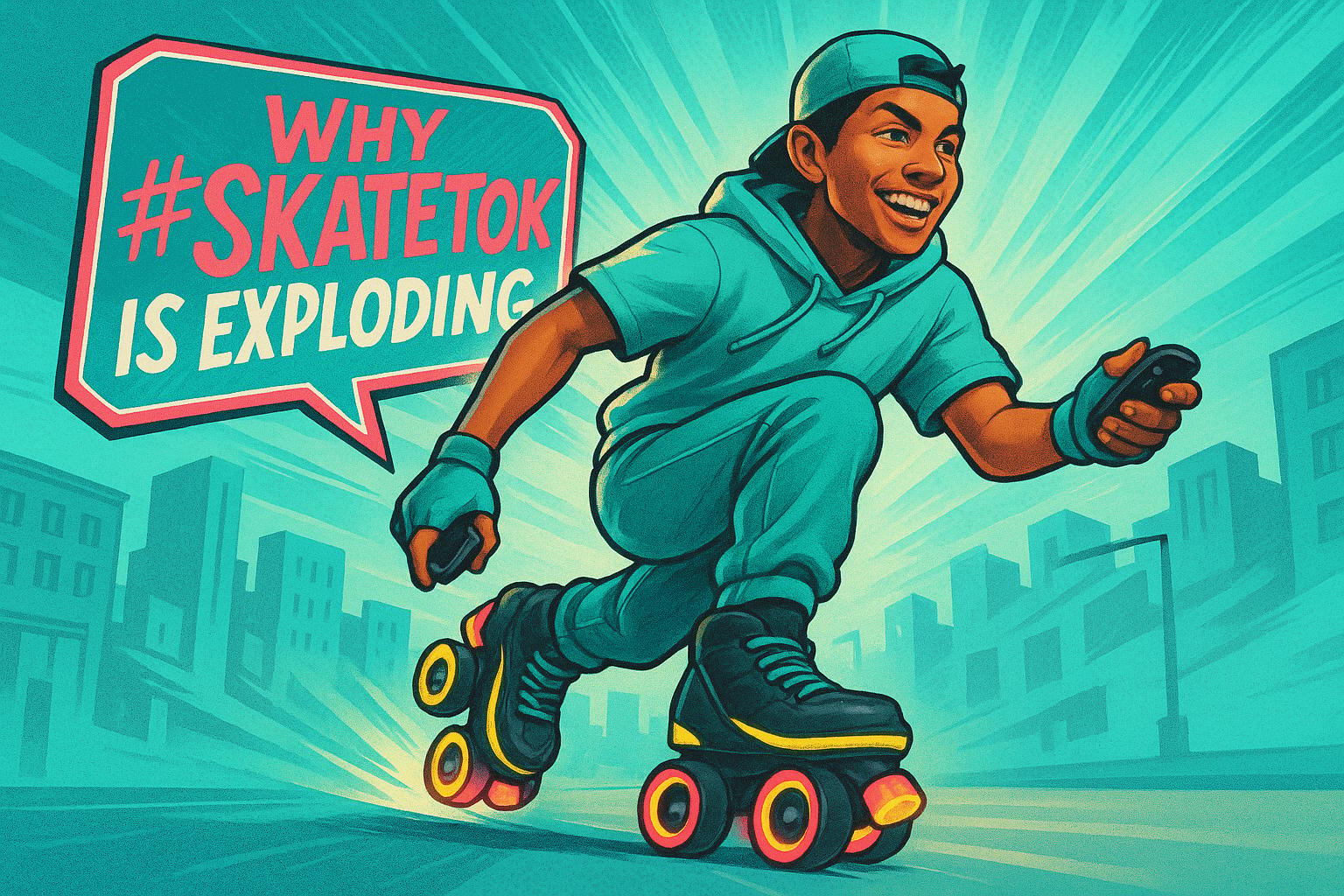Electric roller skates are fun, but they can be risky for kids, especially those aged 6–14. At these speeds, falls can lead to serious injuries, making proper protective gear a must. Here's what you need to know:
- Helmets: Protect against head injuries. Look for CPSC-certified helmets that fit snugly.
- Knee and Elbow Pads: Shield joints from scrapes and bruises. Opt for thick padding with secure straps.
- Wrist Guards: Prevent fractures by stabilizing the wrist during falls.
- Fit and Comfort: Gear should fit well without being restrictive. Adjustable straps and breathable materials help.
- Maintenance: Replace helmets every 3–5 years or after a crash. Check pads and straps regularly for wear.
How to Put on Roller-Skate Protective Gear for Kids
Safety Risks of Electric Roller Skating for Children
Electric roller skates can pick up speed quickly, often catching young skaters off guard. This rapid acceleration can make it hard for children to stay in control, especially when they come across small obstacles like sidewalk cracks or loose pebbles. The sudden speed and unexpected challenges increase the chances of falls.
Using electric skates requires constant balance and precise weight shifts. For children between the ages of 6 and 14, this can be particularly tough as they are still developing the reflexes and spatial awareness needed to react swiftly in unpredictable situations.
Most Common Skating Injuries
Head injuries are one of the biggest concerns when children fall, especially at higher speeds. A hard impact can lead to concussions or, in severe cases, skull fractures and other traumatic brain injuries. A properly fitted helmet is absolutely crucial to reduce these risks.
Wrist and forearm fractures are also frequent because kids naturally put their hands out to break a fall. The force from a high-speed fall can easily overwhelm their still-developing bones. Wearing sturdy wrist guards can help absorb and spread out the impact, reducing the likelihood of fractures.
Knee and elbow injuries are another common issue. When children twist, slide, or roll during a fall, they can end up with scrapes, bruises, or even sprains. While these injuries aren’t as serious as head trauma, they can still keep young skaters off their feet for a while. Knee and elbow pads offer an extra layer of protection, minimizing the risk of these types of injuries.
U.S. Safety Standards for Children's Skating Gear
When choosing protective gear, look for items that meet U.S. CPSC standards and ASTM F1447 guidelines, which ensure proper impact absorption and durability. Some gear may also meet SNELL standards, which offer an even higher level of protection. Always check for certification labels to confirm the gear meets these safety benchmarks.
For the best fit and protection, make sure the gear matches your child’s age and size. Many safety experts also recommend brightly colored or reflective gear to make children more visible in low-light conditions or near traffic.
Don’t forget about maintenance. Helmets should be replaced every 3–5 years or immediately after a significant impact. Other protective gear, like wrist guards and pads, should be replaced when straps wear out or padding loses its cushioning. Keeping gear in good condition ensures it works effectively as your child grows, offering both safety and peace of mind.
Must-Have Protective Gear for Young Skaters
When it comes to electric skating, having the right protective gear is non-negotiable. It’s all about keeping kids safe while they enjoy the thrill of skating. The essentials? A helmet, knee pads, elbow pads, and wrist guards. Together, these pieces create a safety net for the head, joints, and other vulnerable areas in case of a fall. Let’s dive into the details, starting with the most important item: the helmet.
Helmets: What to Look For and How to Fit Them
A helmet is the cornerstone of skating safety, as head injuries can have serious, long-term consequences. When shopping for a kids' helmet, make sure it has a CPSC certification - this guarantees it meets federal safety standards for impact protection.
Multi-sport helmets are a great choice for electric skating because they’re designed to handle similar risks and often include better ventilation than standard bike helmets. This added airflow can make a big difference during longer skating sessions. Avoid older bike helmets that might not provide enough coverage, especially around the back of the head.
To ensure a proper fit, the helmet should sit level on the head, with the front edge about an inch above the eyebrows. The chin strap should be snug, allowing just one finger to fit underneath. Many helmets come with adjustable sizing systems, like dials or sliding mechanisms, which make it easy to tweak the fit as your child grows.
Knee Pads, Elbow Pads, and Wrist Guards
Knee pads are a must for protecting against scrapes, bruises, and more serious injuries caused by falls on hard pavement. Look for designs with thick foam padding and a tough outer shell that can handle impacts with concrete or asphalt. Wide straps are key - they help keep the pads secure without digging into the skin.
Elbow pads serve a similar purpose but need to offer more flexibility since kids rely on their arms for balance and movement. Pads with breathable mesh backing can help reduce sweating and keep your child comfortable. Make sure the pads fully cover the elbow joint and extend slightly above and below for complete protection.
Wrist guards are crucial because kids instinctively use their hands to break a fall. The best wrist guards feature rigid plastic splints on both the palm and the back of the hand, which prevent the wrist from bending too far in either direction. Look for guards that extend from the mid-forearm to the mid-palm for optimal coverage.
All pads should come with adjustable Velcro straps that kids can easily manage themselves. This not only encourages proper use but also ensures the gear stays securely in place during skating sessions. Now, let’s explore how to choose between hard-shell and soft-shell protection depending on your child’s needs.
Hard-Shell vs. Soft-Shell Protection Comparison
The choice between hard-shell and soft-shell gear often comes down to your child’s skating style, comfort preferences, and the type of surfaces they skate on. Here’s a quick breakdown of the differences:
| Feature | Hard-Shell Protection | Soft-Shell Protection |
|---|---|---|
| Protection | Best for high-speed falls and rough surfaces | Suitable for moderate impacts and indoor use |
| Comfort Level | Can feel bulky and less comfortable | Offers a more flexible, comfortable fit |
| Durability | Extremely durable for repeated impacts | May wear out faster with frequent use |
| Mobility | Slightly restricts movement | Allows full range of motion |
| Best For | Outdoor skating and beginners | Indoor skating and experienced skaters |
Hard-shell gear is ideal for younger skaters or those just starting out, especially if they’re skating outdoors. Its rigid design spreads the impact force over a larger area, offering better protection. Soft-shell gear, on the other hand, provides more comfort and mobility, making it a great choice for skaters who already have good balance and control.
Some parents opt to begin with hard-shell gear for maximum safety and then switch to soft-shell options as their child becomes more skilled and confident. This approach strikes a good balance between protection and comfort as kids progress in their skating journey.
Best Protective Gear Products for Ages 6–14
When it comes to electric skating, safety should always come first - especially for kids. Picking the right protective gear can feel like a daunting task, but it doesn’t have to be. By focusing on a few key factors, you can find gear that not only keeps young skaters safe but also aligns with their sense of style. Below, we break down what to look for in helmets and pads to ensure they meet safety standards while appealing to kids.
Top Kids' Helmet Considerations
A reliable helmet is the foundation of any skater's safety gear. When shopping for one, keep these points in mind:
- Safety certifications: Always choose helmets that meet recognized safety standards to ensure maximum protection.
- Low-profile design: Opt for a sleek, non-bulky design that kids will actually want to wear.
- Adjustable fit system: Look for helmets with adjustable straps or dials to accommodate growing kids.
- Ventilation: Select helmets with adequate ventilation to keep your child cool during longer skating sessions.
These features ensure that the helmet not only provides essential protection but is also comfortable and kid-friendly.
Key Features for Knee, Elbow, and Wrist Pads
Once you’ve secured a good helmet, it’s time to focus on pads that protect other vulnerable areas. Here’s what to look for:
- Complete sets: Choose sets that include knee pads, elbow pads, and wrist guards for full coverage.
- Secure closures: Hook-and-loop fasteners are crucial for keeping pads firmly in place, even during active movement.
- Impact-absorbing materials: High-quality padding helps reduce the force of falls, offering better protection.
- Flexibility and durability: Look for designs that balance flexibility with strong, dependable protection.
These features make sure the pads are practical for the fast-paced movements of electric skating while providing peace of mind for parents.
Fun and Functional Gear Designs
Let’s face it - kids are more likely to wear safety gear if it’s fun and reflects their personality. Consider gear that incorporates:
- Bright colors or custom accents: Let your child choose vibrant designs or customizable elements that match their style.
- Visibility features: Glow-in-the-dark details or reflective strips can enhance safety during evening or low-light skating.
- Streamlined design: Avoid overly bulky gear that might feel restrictive, ensuring comfort without sacrificing protection.
sbb-itb-bf837b9
Getting the Right Fit and Keeping Kids Comfortable
Once you've picked out the right gear, the next step is making sure it fits properly and stays in good shape. Even the most protective equipment won't do its job if it doesn't fit right or if your child refuses to wear it because it's uncomfortable. A proper fit is key to both safety and comfort, and it all starts with accurate measurements and adjustments.
How to Measure for Protective Gear
Start by measuring your child’s head where the helmet will sit. For knee and elbow pads, measure around the widest part of the joint while it’s slightly bent. For wrist guards, measure just below the knuckles. Once you have these measurements, compare them to the manufacturer’s sizing chart to find the best match.
Adjusting Straps and Ensuring a Secure Fit
For helmets, make sure it sits level on your child’s head, with the front edge just above the eyebrows. Use the adjustable straps to get a snug fit, following the guidelines provided. Test the fit by having your child move their head in all directions - the helmet should stay securely in place. If it shifts or feels loose, adjust the straps or try a different size.
When fitting pads, start with the straps slightly loose, then tighten them until the gear is snug but not restrictive. The pads should stay in place as your child moves and bends, without cutting off circulation or causing discomfort. Let your child try out basic movements while wearing the gear to ensure it doesn’t shift or pinch. If it does, readjust or consider replacing it.
A proper fit not only keeps your child safe but also ensures the gear is ready for regular care and maintenance.
Cleaning and Replacing Gear
Well-fitted gear works best when it’s clean and in good condition. After each use, wipe down hard surfaces with a damp cloth and mild detergent. For fabric parts, hand wash with gentle detergent and let them air dry to avoid damage from heat, which can weaken padding and elastic materials.
Inspect the gear regularly for signs of wear, such as cracks, compressed padding, frayed straps, or broken buckles. Any damaged gear should be replaced immediately, as it may no longer provide adequate protection. Since kids grow quickly, it’s also a good idea to check the fit periodically - especially after growth spurts - to make sure their gear continues to keep them safe and comfortable.
Finding Gear That's Safe, Comfortable, and Cool
Getting kids to wear safety gear can be tricky. Even the best helmet won't do much good if it stays in the closet because it's uncomfortable or "uncool." The trick is finding gear that blends safety, comfort, and a touch of style to match your child's vibe. Here's how to pick gear that works perfectly with Wheelfeet skates and keeps your child both protected and excited to skate.
Choosing Gear That Works with Wheelfeet Skates

Wheelfeet electric skates can hit speeds of up to 15 mph, so safety gear isn't just a suggestion - it's a must. But with their lightweight and nimble design, the gear you choose needs to complement that agility without weighing your child down.
- Helmets: Look for low-profile helmets that fit snugly and stay put during quick turns or speed adjustments. Bulky helmets can throw off balance, especially for younger skaters, so opt for sleek designs that meet safety standards while being lightweight.
- Knee and Elbow Pads: Flexibility is key. Wheelfeet skates are all about smooth gliding and sharp directional changes, so stiff pads can feel restrictive. Go for pads made with breathable, lightweight materials that move naturally with your child.
- Wrist Guards: Choose wrist guards that offer solid protection but still allow for a full range of motion. They should feel like an extension of the skater, not a hindrance.
When selecting gear, think of it as an extension of the skates themselves - lightweight, maneuverable, and built for action.
Making Safety Gear Appeal to Kids
Let’s be real: if kids don’t like how something looks, they probably won’t wear it. That’s why making safety gear visually appealing is just as important as ensuring it’s functional.
- Get Them Involved: Let your child help pick out their gear. Look for helmets and pads that come in bold colors, fun patterns, or themes that match their personality. When they feel a connection to their gear, they’re more likely to wear it.
- Comfort is Key: Features like adjustable ventilation in helmets, moisture-wicking linings in pads, and no-pinch straps can make a world of difference. If it feels good to wear, it’s more likely to stay on.
- Matching Sets: Coordinated gear can feel like a cool outfit rather than a collection of random pieces. A unified look can make safety gear feel like part of the fun, not just a requirement.
Frame safety gear as something that enhances their skating experience - boosting confidence and enabling them to try new moves without worry. This positive spin helps kids see their gear as a tool for adventure, not just a rule to follow.
Conclusion: Keeping Young Skaters Safe and Happy
Safety and style don’t have to be at odds. When it comes to protective gear for young skaters, the trick is finding equipment that keeps them safe while also being comfortable and cool enough for them to actually want to wear.
The right fit is non-negotiable. A helmet that shifts around or pads that don’t stay in place won’t do their job when it matters most. Take the time to measure correctly, adjust straps, and ensure everything fits snugly before your child hits the pavement.
Investing in quality gear isn’t just about protection - it’s about peace of mind. When your child is equipped with a properly fitted helmet, knee pads, elbow pads, and wrist guards, they can focus on the joy of skating without fear of injury. This confidence often helps them improve their skills and enjoy more daring adventures.
Good safety gear should feel like a natural part of the skating experience. Look for lightweight, breathable materials that move with your child and reflect their personal style. Let them help pick out their gear - when kids like how their equipment looks and feels, they’re much more likely to wear it without a fuss.
Don’t forget to check and maintain the gear regularly. As your child grows and their skating abilities advance, keeping their equipment in top shape ensures they stay safe while having fun.
FAQs
How can I make sure my child's protective gear fits well and keeps them safe while skating?
To make sure your child's protective gear is both comfortable and effective, start by selecting items that fit snugly without limiting movement or causing irritation. For helmets, measure your child’s head circumference and adjust the straps so they’re secure but not overly tight. Knee, elbow, and wrist pads should stay in place without pinching or rubbing against the skin.
It’s a good idea to check the fit regularly, especially as your child grows, and replace any gear that becomes worn out or no longer fits properly. Prioritizing comfort and the right fit helps keep your child safe and confident while skating.
What’s the difference between hard-shell and soft-shell protective gear, and how do I choose the right one for my child?
When it comes to protective gear, hard-shell designs offer a tough outer layer that excels at absorbing impacts and standing up to wear and tear. This makes them a solid choice for activities like skating on rough terrain or biking at faster speeds, where the risk of falls or collisions is higher.
On the other hand, soft-shell gear is crafted from padded, flexible materials, prioritizing comfort and freedom of movement. This type of gear is a better fit for casual skating or activities with lower impact, where ease and flexibility are more important.
To decide which is right for your child, think about their activity level and the environment they’ll be in. Hard-shell gear provides stronger protection for more intense activities, while soft-shell gear is ideal for everyday use. Whichever you choose, make sure the gear fits snugly to ensure both safety and comfort.
When should I replace my child's protective skating gear, and what are the signs it needs to be replaced?
When it comes to your child's protective skating gear, keeping an eye out for wear and tear is crucial to their safety. Check for cracks, dents, tears, or worn-out padding on helmets, knee pads, elbow pads, and wrist guards. If any item no longer fits well or has lost its cushioning, it’s time to replace it.
Helmets, in particular, should be swapped out every five years or sooner if they’ve been damaged or your child has outgrown them. Regularly inspect the gear to make sure it’s secure and comfortable - your child’s safety depends on it.




Leave a comment
All comments are moderated before being published.
This site is protected by hCaptcha and the hCaptcha Privacy Policy and Terms of Service apply.